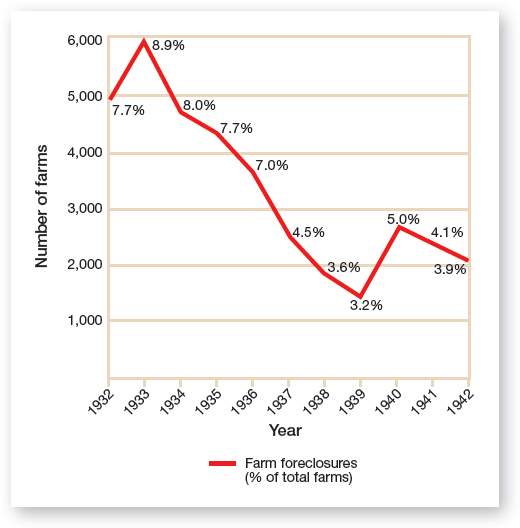The Season of Discontent

As the depression deepened, angry citizens found a variety of ways to express their discontent. Farmers had suffered economic hardship longer than any other group. Even before 1929, they had seen prices spiral downward, but in the early 1930s agricultural income plummeted 60 percent, and one-third of farmers lost their land (Figure 22.2). Some farmers decided that the time had come for drastic action. In the summer of 1932, Milo Reno, an Iowa farmer, created the Farm Holiday Association to organize farmers in order to keep their produce from going to market and thereby raise prices. Strikers blocked roads and kept reluctant farmers in line by smashing their truck windshields and headlights and slashing their tires. When law enforcement officials arrested fifty-five demonstrators in Council Bluffs, thousands of farmers marched on the jail and forced their release. The boycott spread to Nebraska and Wisconsin, and the violence increased. Despite armed attempts to prevent foreclosures and the intentional destruction of vast quantities of farm produce, the Farm Holiday Association failed to achieve its goal of raising prices.
Disgruntled urban residents also resorted to protest. Although the Communist Party remained a tiny group of just over 10,000 members in 1932, it played a large role in organizing the dispossessed. In major cities such as New York, Communists set up unemployment councils and led marches and rallies demanding jobs and food. In Harlem, the party endorsed rent strikes by African American apartment residents against their landlords. Party members did not confine their activities to the urban Northeast. They also went south to defend the Scottsboro Nine and to organize industrial workers in the steel mills of Birmingham and sharecroppers in the surrounding rural areas of Alabama. On the West Coast, Communists played an active role in the motion picture business, unionized seamen and waterfront workers, and led strikes.
One of the most visible protests of the early 1930s centered on events at the Ford factory in Dearborn, Michigan. As the depression worsened after 1930, Henry Ford, who had initially pledged to keep employee wages steady, changed his mind and reduced wages. The paternalistic Ford declared that it was “a good thing the recovery is prolonged. Otherwise people wouldn’t profit by the illness.” His laborers thought otherwise. On March 7, 1932, spearheaded by Communists, three thousand autoworkers marched from Detroit to Ford’s River Rouge plant in nearby Dearborn. When they reached the factory town, they faced policemen indiscriminately firing bullets and tear gas, which killed four demonstrators. The attack provoked great outrage. Around forty thousand mourners attended the funeral of the four protesters; sang the Communist anthem, the “Internationale”; and surrounded the caskets, which were draped in a red banner emblazoned with a picture of Bolshevik hero Vladimir Lenin.
Protests spread beyond Communist agitators. The federal government faced an uprising by some of the nation’s most patriotic and loyal citizens—World War I veterans. Scheduled to receive a $1,000 bonus for their service, unemployed veterans could not wait until the payment date arrived in 1945. Instead, in the spring of 1932 a group of ex-soldiers from Portland, Oregon, set off on a march on Washington, D.C., to demand immediate payment of the bonus by the federal government. By the time they reached the nation’s capital, the ranks of this Bonus Army had swelled to around twenty thousand veterans. They camped in the Anacostia Flats section of the city, constructed ramshackle shelters, and in many cases moved their families in with them. After intensive lobbying efforts, the House approved a bonus bill, but the Senate rejected it. Discouraged, many veterans abandoned the makeshift camps and returned home.
The rest of the Bonus Army remained in place until late July. The Hoover administration declined to negotiate with the demonstrators. When Hoover decided to clear the capital of the protesters, violence ensued. Rather than engaging in a measured and orderly removal, General Douglas MacArthur overstepped presidential orders and used excessive force to disperse the veterans and their families. The Third Cavalry, commanded by George S. Patton, torched tents and sent their residents fleeing from the city. The “Battle of Anacostia Flats” left more than one hundred marchers wounded and one dead.
In this one-sided battle, the biggest loser was President Hoover. Through four years of the country’s worst depression, Hoover had lost touch with the American people. His cheerful words of encouragement fell increasingly on deaf ears. As workers, farmers, and veterans stirred in protest, Hoover appeared aloof, standoffish, and insensitive.
Review & Relate
|
How did President Hoover respond to the problems and challenges created by the Great Depression? |
How did different segments of the American population experience the depression? |